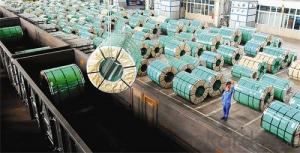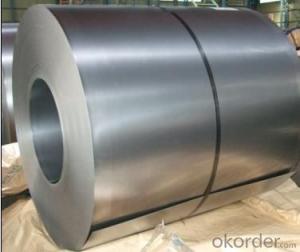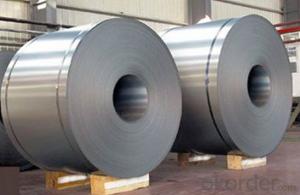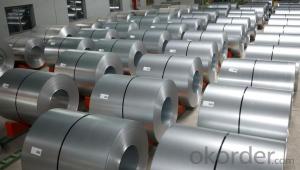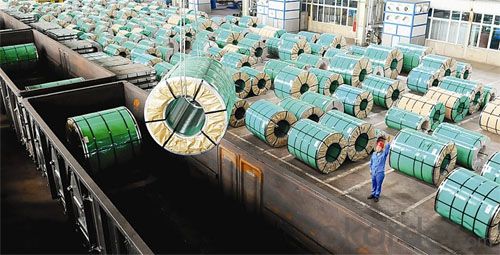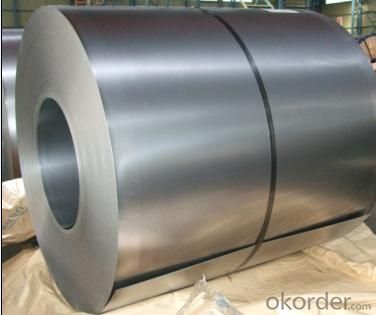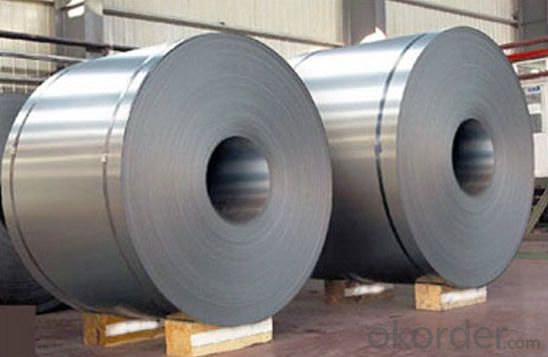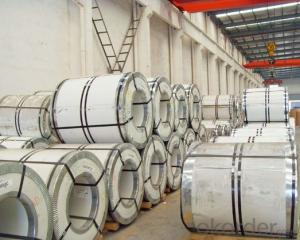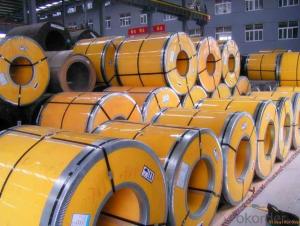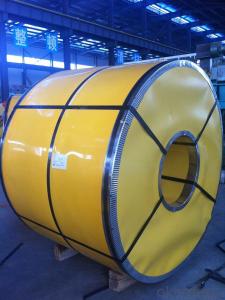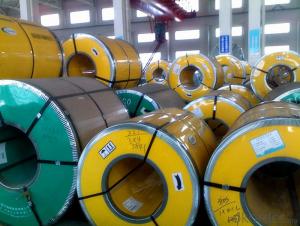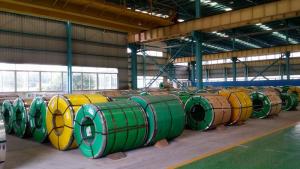Stainless Steel Sheet 304 Cold Rolled 2B Finish
- Loading Port:
- Ningbo
- Payment Terms:
- TT OR LC
- Min Order Qty:
- 100 m.t.
- Supply Capability:
- 20000 m.t./month
OKorder Service Pledge
OKorder Financial Service
You Might Also Like
Cold Rolled Stainless Steel Coil 304 Grade 2B Finish
Packaging Detail: standard export packing or as customer's requirements
Delivery Detail: 7-15 days after the order
Standard: | AISI,ASTM,BS,DIN,GB,JIS | Grade: | 304 | Thickness: | 0.3-3.0mm |
Place of Origin: | China Mainland | Brand Name: | CNBM | Model Number: | 304 |
Type: | Steel Coil | Technique: | Cold Rolled | Surface Treatment: | 2B, BA |
Application: | Medical instruments, building, chemical food industry agriculture | Width: | 500-2000mm | Length: | Coil |
finish: | 2B, BA | item: | 304 cold rolled stainless steel coil | density: | 7.93 |
- Q: Are stainless steel strips suitable for welding with other materials?
- Stainless steel strips possess the capability to be welded with other materials, rendering them suitable for such purposes. Renowned for its remarkable corrosion resistance and formidable strength, stainless steel is widely favored across diverse applications. In welding, stainless steel strips can be effectively joined with materials like carbon steel, aluminum, and nickel alloys. However, it is crucial to meticulously consider the disparities in properties and composition between the materials being united in order to adhere to appropriate welding procedures. Furthermore, the selection of welding technique and filler material may differ based on the specific application and desired outcomes. In summary, stainless steel strips can be successfully welded with other materials, but it is of utmost importance to seek advice from welding professionals or consult welding guidelines to guarantee a robust and dependable bond.
- Q: Can stainless steel strips be used in the agriculture industry?
- Yes, stainless steel strips can be used in the agriculture industry. They are commonly used for various applications such as constructing agricultural machinery, irrigation systems, storage tanks, and animal housing. Stainless steel's corrosion resistance, durability, and hygienic properties make it well-suited for withstanding the harsh conditions and requirements of the agriculture industry.
- Q: Can 111 stainless steel strips be formed into complex shapes?
- Yes, 111 stainless steel strips can be formed into complex shapes. Stainless steel is a highly versatile material that is known for its excellent formability. It can be easily bent, shaped, and manipulated into various complex geometries. The number of strips, in this case being 111, does not limit the ability to form complex shapes. The process of forming stainless steel strips into complex shapes may involve techniques such as bending, rolling, stamping, or welding, depending on the desired final shape. With the right tools, expertise, and techniques, stainless steel strips can be transformed into intricate and complex shapes for various applications in industries such as architecture, automotive, aerospace, and more.
- Q: How does stainless steel strip compare to other types of metal strips?
- Stainless steel strip is renowned for its exceptional resistance to corrosion, its high strength, and its durability. These qualities distinguish it from other types of metal strips. Unlike carbon steel or aluminum strips, stainless steel strip does not easily rust or stain, even in harsh environments. This characteristic makes it highly suitable for applications where exposure to moisture, chemicals, or extreme temperatures is a concern. In terms of strength, stainless steel strip often surpasses other metal strips, enabling it to withstand heavy loads and high-stress applications. It also possesses excellent ductility, allowing it to be easily molded and formed into various configurations without compromising its structural integrity. Another advantage of stainless steel strip lies in its aesthetic appeal. It possesses a sleek and polished appearance that is frequently sought after in architectural, decorative, and industrial applications. Furthermore, stainless steel strip is easy to clean and maintain, making it a popular choice in industries such as food processing and medicine, where hygiene is crucial. Despite its numerous advantages, stainless steel strip may not be suitable for every application. It tends to be more expensive when compared to other metal strips such as carbon steel or aluminum. Additionally, stainless steel strip may exhibit lower electrical and thermal conductivity in comparison to metals like copper. Ultimately, the choice of metal strip material hinges on the specific requirements of the application at hand. Stainless steel strip is the preferred option when corrosion resistance, strength, durability, and aesthetics are of paramount importance. However, it is crucial to take into account other factors such as cost and conductivity when making a decision.
- Q: What are stainless steel strips?
- Stainless steel strips are thin, elongated pieces of stainless steel that are commonly used in various industries for their corrosion resistance, durability, and aesthetic appeal. They are typically produced through a cold rolling process which results in a smooth and polished surface, making them ideal for applications such as construction, automotive, kitchenware, and electronic components.
- Q: What are the common uses of stainless steel strips in the kitchen?
- Due to their unique properties and benefits, stainless steel strips find widespread use in the kitchen. An example of this is their common application for kitchen countertops and backsplashes. With their resistance to stains, heat, and corrosion, stainless steel strips are chosen as a durable and hygienic option for food preparation areas. Another way stainless steel strips are commonly employed in the kitchen is for the construction of kitchen appliances. Manufacturers often utilize stainless steel strips to craft the outer surfaces of refrigerators, dishwashers, ovens, and microwaves. This choice is driven by stainless steel's ease of cleaning, resistance to fingerprints, and ability to lend a sleek and modern appearance to the appliances. Stainless steel strips are also utilized for kitchen utensils and cutlery. The robustness and corrosion resistance of stainless steel make it an ideal material for crafting knives, forks, spoons, and other cooking tools. Stainless steel utensils not only endure for a long time but also resist rust and staining, ensuring their longevity and maintaining their visual appeal. Moreover, stainless steel strips are frequently employed for kitchen sinks. Stainless steel sinks are highly sought after due to their durability, low-maintenance nature, and resistance to staining, heat, and scratches. They offer an easy-to-clean and hygienic surface for washing dishes and engaging in food preparation. In addition to these conventional uses, stainless steel strips can be used for shelving, kitchen cabinets, range hoods, and other kitchen fixtures. Overall, stainless steel strips provide numerous advantages such as durability, resistance to corrosion and heat, ease of cleaning, and an elegant appearance, making them a preferred choice for various kitchen applications.
- Q: What are the common uses of stainless steel strips in the HVAC industry?
- Stainless steel strips are commonly used in the HVAC industry for various applications such as manufacturing air ducts, heat exchangers, and ventilation systems. They are also used for fabrication of components like dampers, expansion joints, and hangers. The corrosion-resistant properties of stainless steel make it suitable for these applications, ensuring longevity and durability in harsh environments.
- Q: Are stainless steel strips resistant to fire and high temperatures?
- Indeed, fire and high temperatures pose no threat to stainless steel strips. Stainless steel, a steel alloy infused with chromium, develops a safeguarding oxide layer on its surface. This oxide layer endows stainless steel with exceptional resistance to corrosion, heat, and fire. Consequently, stainless steel can endure elevated temperatures without compromising its durability or form, rendering it an optimal choice for applications necessitating exposure to fire or extreme heat. Furthermore, stainless steel boasts an elevated melting point, typically ranging from 1370 to 1400 degrees Celsius, bolstering its already impressive fire and heat resistance characteristics.
- Q: Can stainless steel strips be heat resistant?
- Yes, stainless steel strips can be heat resistant. Stainless steel is known for its high resistance to heat and can withstand high temperatures without losing its structural integrity or forming deformities.
- Q: How does the price of stainless steel strips compare to other materials?
- The price of stainless steel strips tends to be higher compared to other materials due to its durability and corrosion resistance. However, it offers excellent long-term value and is often preferred for applications where strength and resistance to wear and tear are crucial.
Send your message to us
Stainless Steel Sheet 304 Cold Rolled 2B Finish
- Loading Port:
- Ningbo
- Payment Terms:
- TT OR LC
- Min Order Qty:
- 100 m.t.
- Supply Capability:
- 20000 m.t./month
OKorder Service Pledge
OKorder Financial Service
Similar products
Hot products
Hot Searches
Related keywords
